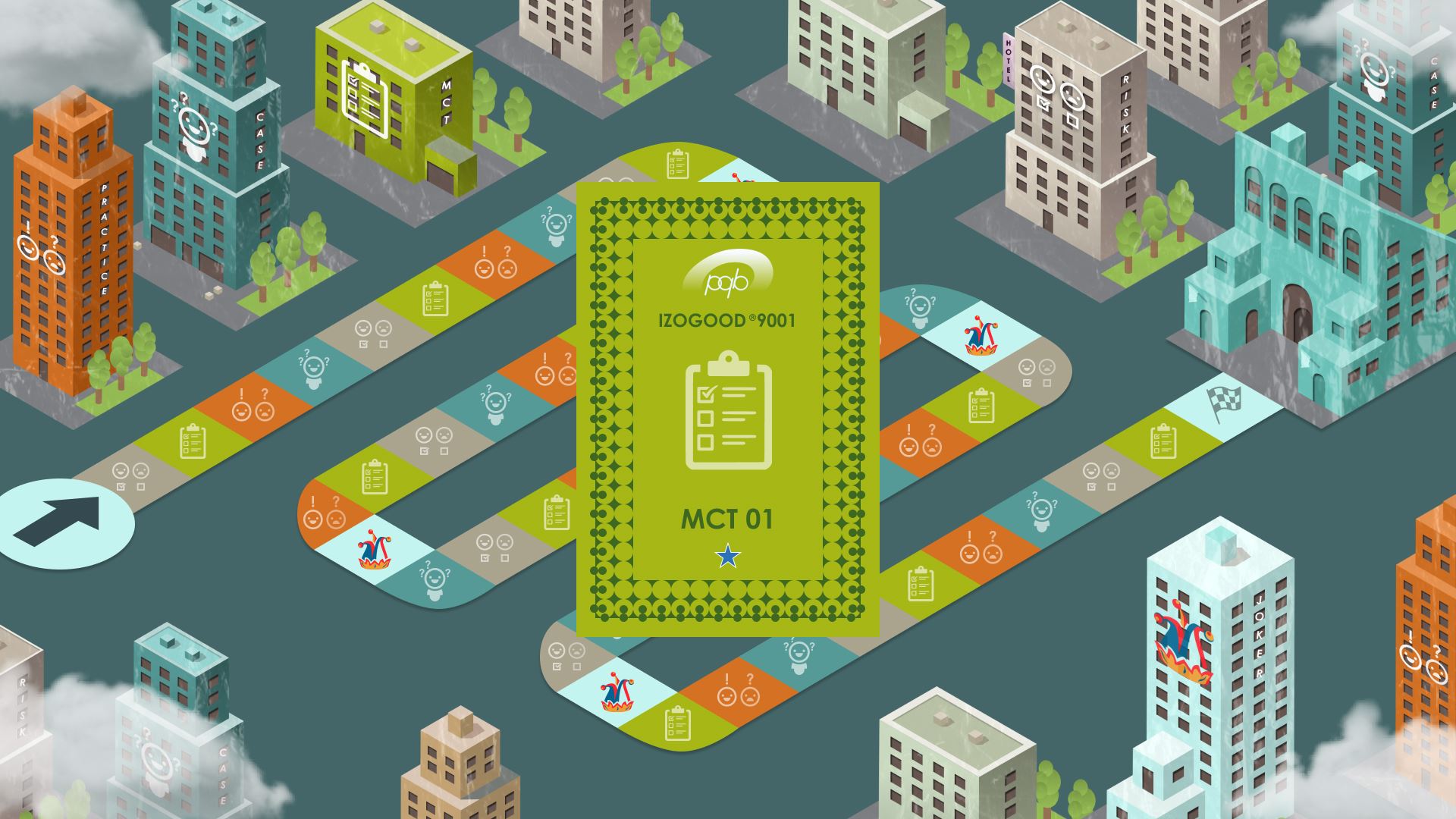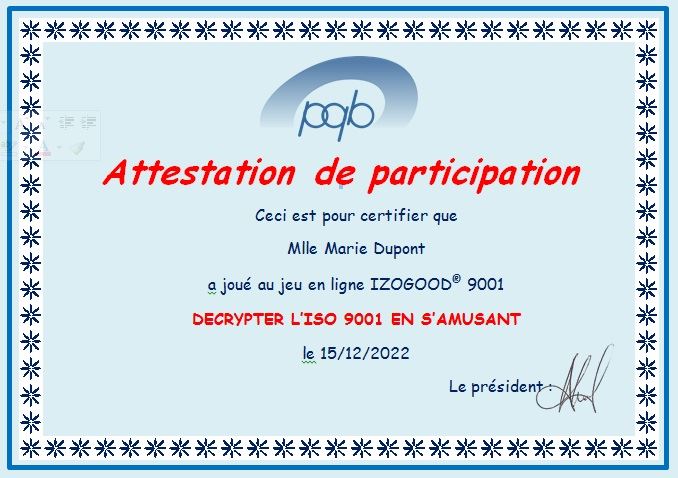.jpg) |
|
Price of a game: 75,00 euros excluding VAT
|
Prerequisites: know the requirements of the standard |

|
 |
|
| Games | Requirements (and quiz) | Free demonstrations without login | The first three cards (risks, MCTs, practices and cases) |
| Quality | Demo IZOGOOD® 9001 | IZOGOOD® 9001 first cards. Decrypt the quality standard while having fun | |
| Automotive | Demo IZOGOOD® 16949 | IZOGOOD® 16949 first cards. Decrypt the automotive standard while having fun | |
| Environment | Demo IZOGOOD® 14001 | IZOGOOD® 14001 first cards. Decrypt the environmental standard while having fun | |
| IZOGOOD® 45001 | OH&S | Demo IZOGOOD® 45001 | IZOGOOD® QSE first cards. Decrypt the OH&S standard while having fun |
| IZOGOOD® QSE | Q.S.E | Demo IZOGOOD® QSE | IZOGOOD® 16949 first cards. Decrypt the QSE standards while having fun |
| IZOGOOD® 22000 | Food | Demo IZOGOOD® 22000 | IZOGOOD® 22000 first cards. Decrypt the food standard while having fun |
| IZOGOOD® 9100 | Aerospace | Demo IZOGOOD® 9100 | IZOGOOD® 9100 first cards. Decrypt the aerospace standard while having fun |
| IZOGOOD® 13485 | Medical devices | Demo IZOGOOD® 13485 | IZOGOOD® 13485 first cards. Decrypt the medical devices standard while having fun |
| IZOGOOD® 22716 | Cosmetics | Demo IZOGOOD® 22716 | IZOGOOD® 22716 first cards. Decrypt the cosmetic standard while having fun |
| IZOGOOD® 27001 | Information security | Demo IZOGOOD® 27001 | IZOGOOD® 27001 first cards. Decrypt the information security standard while having fun |
| IZOGOOD® 37001 | Anti-bribery | Demo IZOGOOD® 37001 | IZOGOOD® 37001 first cards. Decrypt the anti-bribery standard while having fun |
| IZOGOOD® 22301 | Business continuity | Demo IZOGOOD® 22301 | IZOGOOD® 22301 first cards. Decrypt the business continuity standard while having fun |
Customer
The IZOGOOD® games are aimed at:
- certified companies (the quality or QSE manager who wants to make aware staff to the requirements of the management standard)
- consultants (the consultant who wants to accompany the company to the certification or maintenance of the certification)
- universities (the teacher who wants to make his class even more attractive)
THE BENEFITS OF PLAYING TO ASSIMILATE
What is an online game? It is a learning tool that relies on playful challenges, in friendly and benevolent competition.
You wish to decrypt, understand and assimilate the standard of your management system while having fun? So you are in the right place because:
- playing is a favorite activity of the brain
- we learn more easily while having fun
- when we play we forget everything
- the game particularly favors memorization
- the game reduces anxiety associated with learning (participants are in a relaxed state of mind)
- help improve group cohesion
What are the benefits of an online game?
- learn in a fun way by:
- the confrontation of ideas
- team spirit and
- the acquisition of knowledge
- check the achievements
- raise staff awareness
- involve the staff (to take decisions)
- transform the trainer into a facilitator
- build together by:
- friendliness
- benevolence and
- tolerance
- to be enriched by the skills of others (learn from each other)
- assimilate the content of clauses and sub-clauses
- have the desire to play once more time
- identify some of the subtleties of the standard
- be better prepare for the certification
RULES OF THE GAME
The game is intended for one person, but nothing prevents playing in a small group, it will be much more fun.
The game is compatible with recent versions of web browsers. Otherwise the game can be slow.
A gaming session lasts on average between half an hour and 2 – 3 hours. You can play as many times you like during your 60-day access and learn a lot about the standard.
The goal of the game is to get to the last space (Arrival) as quickly as possible..jpg)
The requirements of the standard and comments are accessible by pressing the button Requirements, at the bottom, on the right. A free quiz on the requirements of the standard is provided at the top of the page. This allows you to discover, decrypt and become familiar with the requirements of the standard.
Having a copy of the standard at hand (not included with the game) is a prerequisite.
The board of the game is a city and a journey of the car.
At the top left you have a clock with the elapsed time. At the top right you have a help and a button to exit the game.
At the bottom left you have a button to mute the sound. At the bottom in the middle you have the total of stars earned. At the bottom right you have a button with a link to the requirements of the standard..jpg)
The Demo version allows you to play for free without registration but you are limited to the first three cards of each type (Risk, MCT, Practice, Case).
At the beginning the car is parked at the Start space. .jpg)
The game starts by clicking on the Start game button.
The sequence of spaces (types of cards) is as follows:
- RISK - threat or opportunity - silver
- MCT - multiple choice test - green
- PRACTICE - good or bad practice - orange
- CASE – situation, challenge and solutions - blue
Each type of card contains 50 cards, the response of each card is linked to a sub-clause (paragraph) of the standard.
Each card is shown with the following steps:
- step 1. The card back with card type, number (from 1 to 50) and number of stars (from one to three) in blue, white and red
.jpg) ,
, .jpg) ,
, 
- step 2. The type of card, its number, the question (for example: Is the following statement more of a threat or an opportunity?), the statement (for example: The scope of the QMS describes the main activities of the company) and the star
- step 3. The possible answers (sometimes more than one answer is correct) a green emoji (for a correct answer)
.jpg) and a red emoji (for a wrong answer)
and a red emoji (for a wrong answer) .jpg)
- step 4. The paragraph of the standard and a comment for the correct answer or a comment for the incorrect answer
The car starts and lands on the Risk space.
The card number is random. In relation to the difficulty of the question the stars are one, two or three.
If you guessed the correct answer, the car advances as many spaces as the question contained stars.
If you have not guessed the correct answer (or answered partially) the car stalls on the same space and the next card will be of the same type.
If you land on a Joker space, you move forward 3 spaces. .jpg)
If a second person is next to you and has printed the booklet provided with the game, he can increase the difficulty of the game by asking, among other things, questions like:
- What is the clause ad sub-clause (paragraph) of the standard related to the question asked?
- Can you give an example from your department related to this question?
When you have arrived for the first time at the Arrival space, you can download your Certificate of participation in the IZOGOOD game. 
The educational objectives of the game are to allow each player:
- identify whether a risk is more of a threat or an opportunity
- enrich his knowledge of the requirements of the standard thanks to multiple choice tests
- guess if a statement is rather a good or a bad practice
- study for each proposed case the situation, the challenge and to find the right solution
- decrypt the clauses and paragraphs of the standard and to assimilate the requirements
Some questions have a hint of humor. Dare to be sincere, it's just a game..jpg)
A bias is inevitable as to the “right answers” to be retained, in particular for the RISK or PRACTICE cards.
Below are two examples:
First example: RISK 01 card. Is the following statement more of a threat or an opportunity? "The most important thing is that the company's strategy has been established in the past"
One could answer that it is a threat or an opportunity but it depends on the date on which the strategy was defined.
If you answer that it is a threat, you are right because it is not specified when the previous strategy was developed (one year ago, 10 years ago). So there is missing information. But you might say
it's an opportunity because you think "in the past" means 2-3 years.
Second example: PRACTICE card 02. Is the following statement rather a good or a bad practice? "To determine the challenges of the context, the analysis of the competitive environment
is a priority"
One could answer that it is a good or a bad practice but it depends on the understanding of what is priority. It is relative because each company has a particular context and a way of determining the issues. We believe this is a bad practice because top management must first determine the internal and external issues. But it is legitimate to answer that it is a good practice because there is not really an order of priority to determine the issues of the context where all the interested parties are to be analyzed.
Thus, some answers and the relevance of the comments presented are relative, in the end the truth is sometimes questionable.
The IZOGOOD game was created and produced with great care. Thank you in advance for informing us of any points of progress that you have identified via the messaging system on this page.



.jpg)

